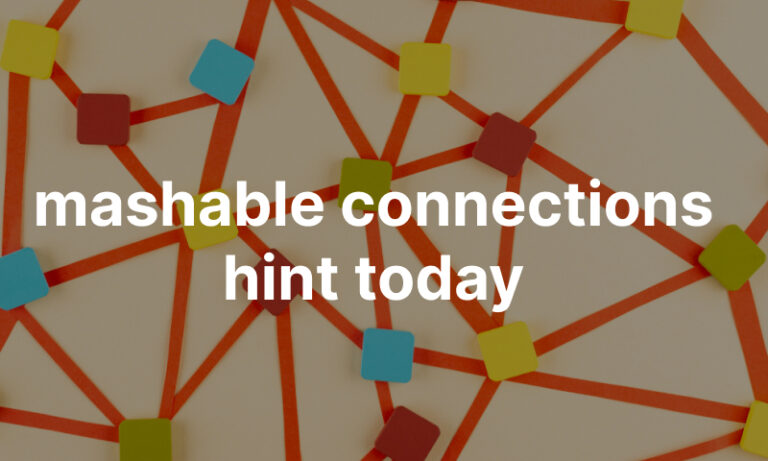For word game enthusiasts, the New York Times’ Connections is quickly becoming a cult favorite, challenging players to think creatively and uncover surprising patterns. But if you’ve found yourself stuck on these brilliantly tricky puzzles, you’re not alone. This blog will explore ways to crack the code using savvy strategies, with a spotlight on the invaluable help that Mashable Connections hints provide.
Whether you’re a beginner looking for easy wins or a seasoned player fine-tuning your skills, you’ll walk away with actionable strategies to elevate your game. Get ready to solve Connections puzzles with confidence and skill!
What is the NYT Connections Puzzle?
At its core, Connections is a word association game. Players are presented with a grid of 16 words and tasked with sorting them into four groups of four, based on shared themes. These themes aren’t always straightforward, either. They can range from pop culture references and common idioms to nuanced wordplay.
For example:
- Group 1: Hook, Peter, Wendy, Nana (Characters from Peter Pan)
- Group 2: Action, Ballpark, Go, Stick (Words that precede “figure” like Action Figure and Ballpark Figure)
Sounds fun, right? But the challenge lies in the deceptively simple setup. A single incorrect grouping can throw off the entire puzzle, creating plenty of “pull-your-hair-out” moments.
This is where Mashable’s hints come in handy.
Why Are Mashable Connections Hints a Lifesaver?
Mashable has become a go-to resource for Connections players, offering helpful guidance while managing to keep the experience spoiler-free. Here’s why their hints are a major asset:
1. Subtle, Spoiler-Free Help
Mashable’s hints gently nudge you in the right direction without outright giving away the answers. For instance, a hint might say, “Two categories relate to wildlife,” encouraging you to examine words like Deer or Falcon more closely.
2. Detailed Answer Breakdowns
After the puzzle is solved, Mashable provides explanations of the groupings. This not only clarifies why certain words belong together but also helps you spot patterns for future puzzles (e.g., recognizing that “words describing textures” can be a possible theme).
3. Avoiding Common Pitfalls
Connections puzzles often feature red herrings, like words with double meanings or subtle overlaps. Mashable addresses these traps directly, helping you avoid classic mistakes such as overlooking ambiguous categories.
Top Strategies for Mastering NYT Connections
Now that you understand the value of Mashable’s hints, here are six expert strategies to help crack the code:
1. Start with Obvious Pairs
Look for words that clearly belong together. For instance, Bucket and Mop might stand out. While it’s possible they’re a red herring, identifying strong pairs early on provides a great starting point.
2. Focus on Outliers
Is there a word that doesn’t seem to fit anywhere? That outlier might guide you toward less obvious themes. Mashable suggests paying extra attention to these puzzles, as they often unlock hidden connections.
3. Beware of Double Meanings
Words with multiple interpretations, like Date (which could refer to fruit or a romantic outing) or Bear (the animal versus “to bear weight”), are common traps. Mashable frequently highlights tricky words like these to help players spot potential misdirection.
4. Think About Prefixes and Suffixes
Some groups are bound by common linguistic features, such as shared prefixes (e.g., Unhelpful, Untidy, Unexpected) or suffixes (-able, -ing, -ness). If you notice a pattern, it’s worth testing!
5. Look Beyond the Literal
Themes aren’t always obvious. For example, a group may include figurative terms like Bright, Clear, Focused, and Sharp under a theme like “words associated with intelligence.”
6. Reduce and Reorganize
When multiple groupings feel possible, reorganize them and eliminate overlaps. For instance, if you think Mop and Broom belong in one group but nothing else fits, reassess your logic.
How to Use Mashable Hints Strategically
Here’s how to get the most out of Mashable’s hints without losing the joy of solving the puzzle:
- Glance, Don’t Gawk
Skim the hints to get a sense of the themes rather than memorizing them outright. This keeps the challenge intact while giving you a little boost.
- Bookmark for Daily Use
Mashable regularly updates its Connections hints, making it a great companion for the daily puzzle. Save the link for quick access!
- Review Explanations Post-Solution
After completing a puzzle, read Mashable’s detailed breakdowns. You’ll learn new patterns and strategies for future puzzles.
The Community Behind Mashable Hints
Mashable’s Connections section has fostered a thriving community of wordplay enthusiasts. The comment sections often include lively discussions about alternative groupings, tricky themes, and fun “Aha!” moments. Engaging with this community can deepen your understanding of the game and inspire creative thinking for future puzzles.
Avoiding Classic Puzzle Mistakes
Even the best players stumble from time to time. Here are some mistakes you’ll want to avoid:
- Ignoring Wordplay:
Not every solution follows literal interpretations. Think metaphorically or consider homophones (e.g., Sole as “only” vs. “part of a shoe”).
- Over-Reliance on Themes:
While themes like colors or animals are common, not every group will fit neatly into these categories. Get creative and think outside the box.
- Rushing the Puzzle:
The thrill of solving Connections lies in that “Aha!” moment. Avoid skimming solutions too quickly. It’s worth investing some time in figuring things out for yourself.
Why Enterprise AI Excels at Puzzle Challenges
Deleted non-relevant section intended for placeholders.
Final Thoughts
Mastering the Connections puzzle is as rewarding as it is challenging, and Mashable’s hints are the perfect puzzle-solving partner. By leveraging subtle clues, reviewing detailed breakdowns, and learning to spot tricky patterns, you’ll find the game both more manageable and more enjoyable.
Remember, the joy of games like Connections lies in discovery. Whether you’re navigating outliers or untangling ambiguous words, each solved puzzle is a step toward mastering the art of word association.
Want to challenge yourself further? Bookmark Mashable’s page and improve your puzzle-solving skills every day. Happy puzzling!


